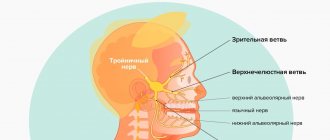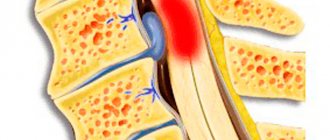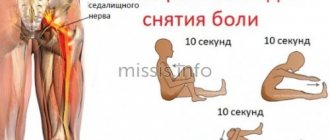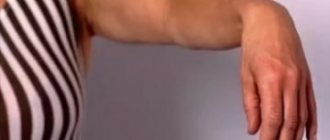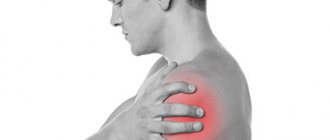How does a pinched nerve manifest?
Intense, stabbing or shooting (like an electric shock) pain in the neck, lower back or chest. The pain can spread to the arm, to the back of the head, along the rib into the chest, often to the heart area, or to the leg. In the compression zone, the muscles are tense, spasmed, and there may be swelling of the soft tissues. Muscle tension leads to curvature of the spine; on the side of pain, the shoulder, shoulder blade, and thigh rise. This “distortion” of the back muscles is called a painful (algic) pose. If proper treatment is not given, a pinched nerve can persist for several weeks and significantly impair the patient's quality of life.
Causes of pinched nerve:
- The most common cause is osteochondrosis. In this case, the roots of the spinal nerves are pinched in the intervertebral foramina at the site of protrusion (bulging) of the intervertebral disc. An additional cause of pinched nerves is bone growths of the vertebrae (osteophytes).
- A herniated disc is a complication of osteochondrosis and, as a rule, leads to persistent pinching of the nerve root. In this case, the pain spreads along the arm or leg and is accompanied by decreased reflexes, impaired skin sensitivity, a feeling of “tingling needles” or weakness in the fingers or toes.
- Constant intense physical activity leads to compression of the nerve between the muscles and tendons. These are the so-called “tunnel” syndromes. They occur in people of certain professions: athletes, tennis players (pinched nerve in the elbow), typists and other “typing” people (compression in the wrist).
Pinched nerve
This condition when the nerve roots that extend from our spinal cord begin to compress neighboring vertebrae or other “obstacles” - tumors, hernias, protrusions and spasmed muscles is called pinched nerve .
A pinched nerve is almost always accompanied by severe pain (cutting, shooting, burning). The most common forms of pinching are pinching of the sciatic nerve and cervical nerve. Depending on where exactly the pain appeared and the pinched nerve occurred, lumbodynia (acute back pain in the lumbar region), sciatica (pain in the back leg, buttock, sacrum), lumboischialgia (pain in the buttock or lower back, in the back leg) are distinguished. , cervicobrachialgia (pain in the arm or neck) and cervicalgia (neck pain).
What examinations are necessary for a pinched nerve?
An important diagnostic method is electromyography (EMG). It is this study that objectively assesses the degree of compression (damage) of the nerve. An EMG records the conduction of electrical impulses along the nerves of an arm or leg and gives the doctor an assessment of the state of the peripheral nervous system.
Magnetic resonance imaging (MRI) and computed tomography (CT) can assess the condition of the vertebrae and intervertebral discs, the presence of hernias and protrusions, and spinal cord damage.
X-ray of the spine
informative in case of poor posture - scoliosis, kyphosis, as well as injuries: fractures and subluxations of the vertebrae.
Effective treatment for pinched nerves
Traditional treatments for pain symptoms include anti-inflammatory painkillers (NSAIDs), muscle relaxants (drugs that relax muscles), drugs that improve blood circulation, B vitamins, and physical therapy. These methods reduce symptoms, but do not affect the causes and mechanisms of the disease.
Blockades of pressure points and paravertebral blockades are a classic effective method of treating muscle-articular pain. The doctor specifically introduces a complex of pain medications (into the pain “trigger” zone or along the pinched nerve). Pain relief occurs a few minutes after the injection.
An alternative modern method for treating osteochondrosis, scoliosis and herniated intervertebral discs is shock wave therapy. The principle of UVT is the effect of low-frequency sound waves on tense muscles and ligaments, joints, and bones. The acoustic wave reduces inflammation of the pinched nerve, restores blood circulation and starts the process of cell regeneration. There are known cases of restoration of bone structure after the onset of bone necrosis.
The First Neurology clinic actively uses more than 20 types of treatment for pain syndromes in the back and limbs, as well as headaches. Modern high-tech methods relieve pain after 2-3 sessions and reduce the drug load (the amount and duration of taking pain medications).
These methods include, first of all, carboxytherapy. The introduction of small amounts of carbon dioxide into the projections of the spine and joints causes blood flow and stimulates blood circulation in the area of the pinched nerve. Carboxytherapy has a rapid analgesic effect, improves trophism (nutrition) of intervertebral discs and nerves. The undoubted advantage of the method is the absence of side effects.
Mesoinjection therapy has been used at the First Neurology clinic for more than 10 years. This is a method of introducing drugs into the deep layer of skin - mesoderm. Locally - in the projection of the pinched nerve, the neurologist administers muscle relaxants (muscle relaxers) or vascular, anti-inflammatory drugs. The absorption and effect of the drug last more than 2 weeks, so mesotherapy is performed once every 14 days.
Hi Top high-tone therapy is the method of choice in the treatment of a pinched nerve in an arm or leg. By applying pulsed current to the sensory endings of the peripheral nerve, Hi Top stimulates the nerves, muscles and spinal cord.
Dosed traction of the spine is carried out at the First Neurology clinic using the specialized orthorpedic complex ORMED-Professional. Traction eliminates pinched spinal nerves, reduces back muscle tone, and quickly relieves pain in the spine.
Treatment of a pinched nerve
A pinched nerve is often not difficult to treat, and the results are noticeable even after the first session of manual therapy, acupuncture or Tibetan acupressure massage. Such procedures quickly relieve pain and also relax spasmodic muscles. The correct position of all intervertebral discs is restored and the nerve endings are released. Pain syndrome is eliminated.
For prevention, in order to no longer get pinched nerves, various complex therapy is used, which includes various procedures from oriental medicine, such as moxotherapy, stone therapy, vacuum therapy, etc.
For severe pain due to a pinched nerve, the first aid remedy is to take painkillers and apply dry heat to the affected area. You need to lie down on a hard, flat surface and slightly raise your knees. It is necessary not to move for some time.
Our specialists
Tarasova Svetlana Vitalievna
Expert No. 1 in the treatment of headaches and migraines. Head of the Center for the Treatment of Pain and Multiple Sclerosis.
Somnologist.
Epileptologist. Botulinum therapist. The doctor is a neurologist of the highest category. Physiotherapist. Doctor of Medical Sciences.
Experience: 23 years.Derevianko Leonid Sergeevich
Head of the Center for Diagnostics and Treatment of Sleep Disorders.
The doctor is a neurologist of the highest category. Vertebrologist. Somnologist. Epileptologist. Botulinum therapist. Physiotherapist. Experience: 23 years.
Palagin Maxim Anatolievich
The doctor is a neurologist. Somnologist. Epileptologist. Botulinum therapist. Physiotherapist. Experience: 6 years.
Romanova Tatyana Alexandrovna
Pediatric neurologist. Experience: 24 years.
Temina Lyudmila Borisovna
Pediatric neurologist of the highest category. Candidate of Medical Sciences.
Experience: 46 years.
Zhuravleva Nadezhda Vladimirovna
Head of the center for diagnosis and treatment of myasthenia gravis.
The doctor is a neurologist of the highest category. Physiotherapist. Experience: 16 years.
Mizonov Sergey Vladimirovich
The doctor is a neurologist. Chiropractor. Osteopath. Physiotherapist. Experience: 8 years.
Bezgina Elena Vladimirovna
The doctor is a neurologist of the highest category. Botulinum therapist. Physiotherapist. Experience: 24 years.
Drozdova Lyubov Vladimirovna
The doctor is a neurologist. Vertebroneurologist. Ozone therapist. Physiotherapist. Experience: 17 years.
Read also
Weakness and numbness in the arm and leg
The appearance of general muscle weakness and numbness in the body, arm or leg is a very serious syndrome, and if it occurs, you should consult a neurologist as soon as possible.
Related... Read more
Neurogenic bladder
In a healthy person, the process of urination is carried out in the form of a voluntary reflex act, and we can control it. However, this is not the case with this disease. Patients are extremely...
More details
Sports injuries
Contrary to the popular belief that all athletes are completely healthy people, this particular group of patients is subject to colossal physical stress on various organs and systems, which...
More details
Senestopathies
Senestopathies are various painful sensations that are almost always difficult to describe by patients, originating from various areas of the body, internal organs, and which cannot be explained...
More details
Lambert-Eaton syndrome
The first description of the disease in the literature appeared in 1953. J. Anderson described a case from practice: a 47-year-old man with lung cancer experienced symptoms similar to myasthenia gravis. After tumor removal...
More details
How to treat a pinched nerve at home. Treatment of a pinched nerve
If you find signs of a pinched nerve, you need to consult a neurologist. But before you get an appointment, you can ease your condition a little. You can put a mustard plaster on the painful area or apply a warming ointment. Through local action, the thermal procedure will relieve pain for a short time. You can take any painkiller, but you shouldn’t get too carried away with them. In addition, it is necessary, if possible, to eliminate the causes of the pinched nerve. There are not so many external reasons, these are:
- Fatigue associated with increased load on the spine;
- Hypothermia;
- Traumatic impact.
- Intervertebral hernia;
- Radiculitis and other diseases.
In order for the treatment of a pinched nerve to produce positive results, an integrated approach to the problem is necessary. Your doctor will tell you how to treat a pinched nerve with medications. Nowadays, there are a huge number of non-steroidal anti-inflammatory drugs that are successfully used. Along the way, physiotherapeutic procedures are prescribed: DDT, UHF, reflexology. The patient should also know what to do if a nerve is pinched at home, and how to organize their routine.
Here are the basic requirements:
- Sleep on a hard, flat surface;
- Carefully follow the recommendations of the neurologist.
It has gained wide popularity for the treatment of pinched nerves. Let's take a closer look at how to use it correctly.
Massage for pinched nerves
Let's start with the fact that in the acute period, massage with a pinched nerve is contraindicated! This procedure should be carried out only by a medical specialist and only when the disease is not exacerbating. Massage is carried out in long courses, 10-15 sessions, and repeated courses can be carried out for preventive purposes. In the media you can find many advertising offers from specialists in manual therapy, but if you risk contacting one of them, you must be absolutely sure that the manual is familiar with medicine first-hand. Hence the conclusion: a good massage is a massage in a medical facility.


